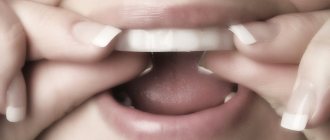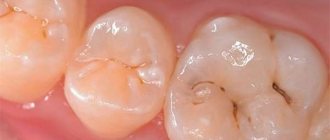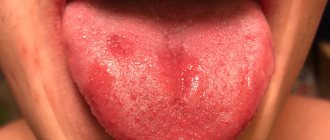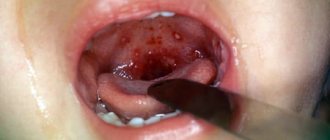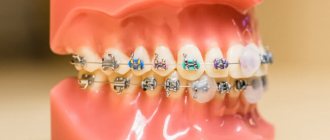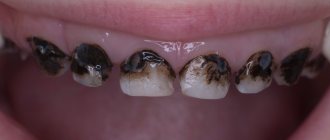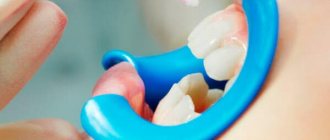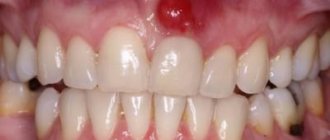A sign of a disease or a feature?
The answer to the question “ Why are teeth yellow ?” cannot be unambiguous. If this is an individual feature, then it depends on the dentin layer, which is located under the enamel. Since enamel is naturally transparent, the white-yellow color of dentin determines the color of the teeth. It is worth noting that this feature is hereditary.
Of course, yellow tooth enamel is also not uncommon. Quite often it is a signal of the development of inflammatory processes in the body. Yellowness can also be different. These may be yellow spots on the teeth , which can be cleaned, but yellowness can also spread to the dental tissues that are located under the surface tissues.
There are many reasons that lead to yellowing of teeth. One of the main ones is demineralization and thinning of the enamel. Other possible reasons:
- smoking - yellow plaque on the teeth appears gradually and changes its color from pale to darker;
- consumption of food and drinks with food dyes, which penetrate into microcracks on the surface of the teeth, causing discoloration;
- the use of potent medications that have a strong effect on the enamel during long-term treatment;
- damage to the pulp due to impacts of a mechanical nature or medical error;
- exposure to acid - prolonged work with it can lead to the appearance of yellow spots on the teeth , which are a sign of the beginning of enamel destruction;
- wearing braces, especially permanent ones, makes it difficult to brush your teeth, which is why yellow spots form in the places where the fastenings are adjacent to the enamel due to the accumulation of bacteria;
- poor and irregular dental hygiene leads to the appearance of yellow plaque, which hardens over time and turns into tartar;
- the presence of common diseases: Addison's disease, fluorosis, jaundice, others.
Brown plaque on teeth and dark spots near the gums on the inside: how to remove stripes
Brown plaque on teeth is not only unsightly, but also not “healthy”. A number of factors lead to its formation, and the gums, tongue, and mucous membranes can be affected. The main types of brown plaque are soft and hard.
It is necessary to remove it, since pathogenic accumulations in the mouth cause an unpleasant odor, can lead to the development of periodontitis and even a decrease in the overall defenses of the body.
You will learn more about the reasons for its formation, methods of treatment and prevention from this review.
Why brown plaque appears on teeth: causes of dark spots
Brown spots can appear on the inside and outside of teeth.
If you notice a characteristic plaque on the surface of the enamel, you can be sure that the gums, oral mucosa, and tongue are also affected.
This layer is an ideal environment for the growth of bacteria, so the problem cannot be left to chance. Read more about the reasons for the appearance of a brown coating on the tongue in this material.
When plaque appears, many intensify the sanitation of the oral cavity. But better hygiene alone is not enough to eliminate the problem.
It is believed that poor oral hygiene leads to the formation of plaque - this is true, but only partly, since just brushing your teeth is not enough to keep your teeth clean.
Brown spots appear as a result of the interaction of water (regular tap or distilled) with fluorides, phosphates, and calcium oxide. These processes are influenced by the structural features of the teeth and jaw system, the presence of gum disease, and the quality and nature of food consumed.
This problem is most familiar to lovers of tea, coffee, wine, citrus fruits and tobacco.
An increased level of bacterial microflora in the mouth is one of the most common causes of brown plaque.
Don’t leave everything as it is - brown plaque on enamel not only looks unsightly, but also causes an unpleasant sour smell, provokes the accumulation and active growth of bacterial flora.
All this is fraught with the appearance of various dental problems, inflammation of the mucous membrane and even general infection of the body.
Untreated teeth, poor sanitation, and plaque accumulation also often lead to a decrease in the body’s overall immunity.
Types: from the inside and outside, under the gums
Main types of dark plaque:
- dentogingival;
- subgingival;
- proximal.
The first type can be on the enamel on any side of the jaw, less often, but this defect also appears along the edge of the gum. Subgingival plaque accumulates at the bottom of the tooth crown and causes damage to the roots and exposure of the neck of the tooth.
In some cases, only a doctor can detect subgingival plaque. The lesion may be hidden under the gum and requires a special probe to identify it.
Proximal dark plaque affects contact surfaces. That is, its area of influence is those areas of the tooth that are in direct contact with food. You may also be interested in learning about the causes of white spots on teeth.
Dark plaque under the gum from the outside or inside must be removed. Otherwise, it will become more dense and will most likely lead to the development of periodontal diseases.
Treatment methods: how to get rid of
In the initial stages of formation, it is easiest to remove plaque. If you have just noticed dark spots on the inner or outer surface of your teeth, but there is no significant discomfort or other problems yet, buy a toothpaste with fluoride and calcium.
You will need to use it regularly. And be sure to visit a dentist - he will conduct a professional teeth cleaning and give recommendations on oral care. After the procedure, the enamel must be treated with special pastes with calcium.
For details and types of anti-tartar pastes, read this material.
The use of calcium paste helps restore dental tissue and protect against mechanical damage.
The treatment regimen for dark spots on tooth enamel often includes, in addition to eliminating visible defects, the destruction of pathogenic flora in the oral cavity.
Some people are allergic to fluoride pastes, which are used by dentists during professional cleanings. An alternative solution is laser plaque removal.
This device has a targeted effect on the layers, strengthens the gums, reduces bleeding and whitens the enamel. Note that this same technology can also be used to eliminate carious formations. Read more about laser dental treatment below.
If you have increased sensitivity, your doctor may recommend hardware cleaning - for example, ultrasonic or air.
Professional teeth cleaning should be done at least once every six months to a year. It is recommended to carry out treatment with special pastes more often - once every 3 months.
Traditional recipes are also used to remove brown spots. Basic:
- Rinse your mouth after every cup of tea and coffee. You can make a soda solution - a teaspoon per glass of water.
- Brushing teeth with activated carbon – grind tablets (2 pieces) into powder and use topically. The recipe does a good job of whitening enamel. The procedure is not carried out more often than once every three days.
- Rubbing the jaws with tomato paste. Use freshly prepared homemade one and keep it on your teeth for 10 minutes.
Treating your teeth with lemon juice, hydrogen peroxide, or baking soda is a very bad idea, since the effect of such cleaning will be short-lived (if at all), and the problems will last for a long time. Aggressive components are contraindicated for sensitive enamel.
Prevention
It is easier to prevent any problem than to eliminate it later - and the formation of dark plaque on teeth is no exception. Basic preventive measures in this case:
- After each meal, rinse your mouth with a special oral care product (rinse) or mineral water (strictly without gases);
The use of a mouth rinse can reduce the formation of plaque and normalize the microflora of the mouth.
- reconsider your diet - add cheeses, carrots, nuts, cereals and apples in large quantities, but it would be advisable to give up soft foods.
- visit an orthodontist - any inflammatory processes or malocclusion are also fraught with the appearance of plaque on the enamel and mucous membranes of the mouth. If wisdom teeth grow abnormally, they will have to be removed, because... They make the cleaning process more difficult and can lead to plaque and caries. Read more about whether to treat or remove wisdom teeth here.
- restore the mechanics of chewing - that is, you need to use both jaws, otherwise the active one will be more susceptible to various diseases.
- check the thyroid gland and the health of the endocrine system as a whole - dental pathologies very often occur with these diseases.
- do not skimp on hygiene products - low-quality materials spoil the enamel and scratch the gums. It should be noted that with poor cleaning, cervical caries can form on the teeth.
- give up fatty fish.
- Drink only bottled water.
- Switch to fluoride-free toothpastes.
Why do soft foods cause dark spots on enamel? The fact is that they do not require prolonged chewing, which means that little saliva is released that cleanses the enamel.
For details about the causes and methods of eliminating brown plaque on teeth, watch the video
Conclusion
Dark plaque on teeth appears as a result of improper care (especially insufficient thorough brushing of teeth), the presence of serious endocrine pathologies, and constant consumption of a certain set of foods (tea, coffee, wine, citrus fruits, etc.).
It is necessary to remove it, otherwise the appearance of bad breath and other diseases (periodontitis, catarrhal gingivitis, decreased immunity, etc.) will not take long to occur. Once every six months to a year, have your teeth professionally cleaned by a dentist using special pastes and be sure to monitor the quality of the water used for drinking and cooking.
Use fluoride-free toothpastes and be sure to restore chewing mechanics (both jaws should be involved in the process of chewing food).
Source: https://ZubZdorov.online/bolezni/simptomy/nalet/korichnevyj-na-zubah.html
How to get rid of yellow teeth?
Whitening yellow teeth can be done at home using special whitening toothpastes. This method is deservedly considered one of the most inexpensive and safe. However, you should not use it for a long time, since such toothpastes have a negative effect on tooth enamel.
If this method does not give the desired effect, professional teeth cleaning with ultrasound is performed. After it is carried out, the enamel is coated with a protective agent. This method is very effective: even teeth that were yellow near the gums before the procedure look noticeably whiter after such cleaning.
Trays are sometimes used for whitening, which are overlays on the teeth filled with a bleaching agent. In this case, treatment is carried out under the supervision of a dentist. Tetracycline stains are removed using ultraviolet light.
If you want your teeth to be strong and healthy, do not forget about regular preventive examinations at the dentist. At the CELT clinic you can consult with experienced specialists who will tell you about all the intricacies of proper oral hygiene.
Tooth cyst: symptoms and consequences
Experts note that diagnosing a cyst, especially in the early stages of its development, is a rather complex process. The fact is that at first, it actually does not manifest itself in any way, and the first sensations of discomfort come when it reaches an impressive size.
At the same time, it is worth noting that the formation of a cyst is a long process. This contains both dangers and positive aspects, which consist in the fact that the patient has the opportunity to identify symptoms that foreshadow the onset of this disease and contact the dentist in time, which will greatly facilitate the treatment process.
The most common symptoms are:
- gradually increasing swelling on the gum near the tooth root. The enlargement process is usually not very rapid, however, it is quite noticeable;
- if a cyst forms in the area of the maxillary sinus, the patient will feel headaches, which often do not go away even after taking medications;
- the occurrence of a fistula, which is a kind of tunnel that indicates the epicenter of inflammation with the outer surface of the gums;
- during the inflammatory process, a general increase in temperature of the whole body, or in the area of cyst formation, is possible.
The symptoms are quite general, as you will notice, so we strongly recommend visiting your dentist more often, who can diagnose the cyst in the early stages using an x-ray, the most accurate way to determine the disease.
What is dangerous about a cyst is that the patient may not be aware of the existing problem for a long time, which is why it can cause major complications, which will make the process of its treatment more difficult.
Yellow spots on teeth: causes and solutions
Healthy and beautiful teeth are every person’s dream. But even children have problems with them. Changes in enamel indicate the development of inflammatory processes in the oral cavity of an infectious nature. Dental problems make mothers worry. Caring parents are sensitive to any health problems in their beloved children. Parents should not panic, but need to understand this problem and understand how it can be solved.
Yellow spots - the initial stage of fluorosis
Causes
The most common reason why a yellow spot appears on a tooth is hypoplasia.
In the absence of proper treatment, the pathology ends in the development of various diseases (caries, destruction of hard tissues). Today, hypoplasia occurs in almost half of children of different age categories. The peculiarity of this pathology is that the tooth erupts with spots. In most cases, the problem occurs only with the front teeth.
Spotty hypoplasia on a child's teeth
The main factors contributing to the development of hypoplasia in children:
- birth trauma or Rh conflict;
- gastrointestinal disease in the mother;
- severe toxicosis in the mother during pregnancy;
- lack of nutrients in breast milk.
Yellow spots on a child’s teeth may also appear for another reason. Often the problem of yellow plaque is a normal plaque that appears as a result of poor hygiene procedures. Despite its apparent safety, the raid poses a threat. Because it leads to the appearance of tartar, which creates a favorable environment for bacteria. Without professional treatment, the problem may worsen and gum disease and tooth decay will begin to develop.
Yellow plaque turns into stone over time
- Yellow stone occurs as a result of poor tooth brushing and a lack of solid foods. While plaque can be removed with a regular toothbrush, the stone can only be removed in the dentist’s office.
Smoking and alcohol cause yellow spots
- Spots can also appear on baby teeth in the presence of internal diseases: heart pathologies, kidney failure.
- Long-term use of antibiotics may also cause this problem.
- Hereditary developmental pathologies, such as improper formation of dentin or enamel, weakening of tooth tissues, can manifest themselves in the form of spots on the teeth.
- Night bottle feeding of infants has a negative impact on the enamel. At night, less saliva is produced, and foods increase the acidity in the mouth, creating a favorable environment for bacteria. This problem is also called night feeding syndrome. During teething, it is recommended to stop night feedings.
Dental fluorosis is an unpleasant pathology
Reasons for appearance
First, let's figure out what plaque on enamel is.
Yellow plaque is keratinized particles of the mucous membrane, food debris and harmful microorganisms.
To prevent excessive accumulation of plaque on children's teeth, it is recommended to brush them after every meal, especially after sweets and starchy foods.
A yellowish coating on a child’s teeth is not a clear sign of caries and enamel destruction, but it is a harbinger of carious processes in the future and may indicate serious diseases within the fragile body.
Baby teeth are especially snow-white in color, so the appearance of plaque cannot go unnoticed.
Among the reasons for the appearance of yellow plaque are the following::
- Poor or irregular oral hygiene.
- If a child has bad teeth, he may begin to chew food using only one side. Due to the uneven load, food debris will begin to accumulate on one side , which will provoke the formation and accumulation of plaque. This can also happen due to an incorrect bite.
- Incorrectly selected toothpaste and brush.
- Frequent consumption of black tea, coffee drinks and colored sodas.
- If the white coating is not removed in a timely manner, it can be stained by any coloring substances contained in food and drinks.
- Not chewing food thoroughly.
- Lack of solid foods, in particular fresh fruits and vegetables, chewing which helps get rid of yellow plaque.
- A large amount of food in a child’s diet is high in carbohydrates.
- Poor or thin tooth enamel and poorly developed enzyme system.
- Dysbacteriosis.
- Weak immunity and a decrease in the body’s defenses (may occur due to taking antibiotics, the course of the disease, dry air).
A separate point worth highlighting is the appearance of yellow plaque in infants and one-year-old babies. His diet does not contain harmful or coloring food or drinks, but plaque still appears. What could be the reason?
Most often, this symptom is a harbinger of bottle caries . It is one of the most common forms of caries in children, and can occur due to prolonged feeding of the baby from a bottle with a pacifier. Drinking sugary drinks before bed, or directly at night, has a particularly bad effect on children's fragile enamel. This form of caries develops very quickly and can completely destroy teeth.
How to deal with yellow stains on teeth
Under no circumstances should you self-medicate or experiment with your baby’s health using various folk remedies. The only correct solution when this problem occurs is to show the child to the dentist. Because only a specialist can remove yellow spots on enamel.
It is simply impossible to solve this problem on your own at home.
Initial caries on a child's teeth
Self-medication will not help with this disease and will harm the child’s health. Under no circumstances should you try to scrape off the stain, because the enamel will be damaged even more. Parents should also forget about the habit of licking the baby’s spoon or pacifier. If they have caries, the problem will be passed on to the child.
Parents should pay special attention to the baby's nutrition. If the baby eats only breast milk, then the mother should include foods rich in nutrients, minerals and vitamins in her diet. Ideally, a nursing mother should follow a special diet for breastfeeding. If this is not possible, then you can simply increase the amount of fresh vegetables and fruits. For older children, parents should create a diet that includes only healthy foods.
Read also: Caries symptoms and treatment
Bottle caries in children under 3 years of age
The child must consume fermented milk products and milk every day. Because they contain a high content of calcium, which helps strengthen teeth. But nutrition cannot replace professional treatment. Don't put off visiting the dentist for too long. The specialist will examine the child and prescribe examination by other specialists to identify concomitant diseases that provoked this problem. Additional tests (blood and urine) may also be required to identify internal diseases that could cause a dental problem.
Destruction of tooth enamel due to hypoplasia
There is an opinion that baby teeth that do not hurt do not need to be treated because they will soon fall out. But this is a mistaken opinion. Stains are not just a cosmetic defect. This disease is transmitted to the molars. If the problem appears as a result of some disease, the sooner an accurate diagnosis is made, the more effective the treatment will be. Thanks to modern methods and technologies, even children can undergo dental procedures painlessly.
Yellow tartar
To preserve the enamel of the youngest patients, painless procedures such as fluoridation, varnish and silver plating are used.
Special formulations have the ability to remove stains. When the baby grows up, he will receive full treatment.
Therapy for yellow spots is carried out using remineralization. The procedure is painless and absolutely harmless to the child. The specialist applies a special paste enriched with minerals to the teeth. Penetrating deep into the tooth, the active substances restore it from the inside. In the event that hyperplasia has not been treated for a long time and is in a neglected state, it will be necessary to carry out full treatment, as with caries. The specialist will use a drill to remove damaged tissue, disinfect and restore the shape of the tooth.
Cleaning teeth from stone in a dental office
It is worth remembering that proper nutrition and regular oral hygiene will relieve dental problems.
Parents should teach their children to take care of their teeth and regularly perform oral hygiene procedures from childhood.
Cyst under the crown: what to do?
The appearance of disease under the crown is most often a consequence of incorrect or incorrect installation of the crown itself. As a result, harmful microorganisms begin to actively multiply in the space between the tooth and gum.
What are they doing to prevent this from happening?
- if the cyst is small, there is no need to remove the crown, and treatment takes place without direct surgical intervention;
- with sizes of 8 mm or more there is a risk of tooth loss, but modern treatment methods make it possible to save the tooth. To do this, it is necessary to open the tooth, treat the canals with special preparations that should eliminate the cyst, and after some time the crown is installed back;
- if this method of treatment does not help, resort to resection;
- in particularly severe cases, the tooth must be removed.
In order not to lose a tooth along with its crown, you must regularly consult a doctor and go to the dentist at the first symptoms.
Video: how to treat a dental cyst and what is it?
The appearance of white spots on teeth in children and adults
Tooth enamel can change its structure and color due to the action of exogenous and endogenous factors, or some dental pathologies.
The most common causes are considered to be the presence of caries.
,
enamel hypoplasia
and
fluorosis
.
During the carious process
First, a white chalky stain forms on the tooth. This occurs due to the fact that cariogenic microorganisms secrete special organic acids. And they, in turn, actively contribute to the leaching of calcium salts from the enamel, which leads to its fragility and porosity. The processes of demineralization of tooth enamel are launched.
If treatment is not started at this stage, caries progresses quickly. The affected tooth must undergo sanitation. This also applies to baby teeth in children.
Hypoplasia
is considered to be underdevelopment of the tooth itself or some of its tissues. Usually it is a congenital defect, established at the time when the embryo was formed in the womb. A weak degree of hypoplasia is a changed color, manifested by white spots with clear boundaries.
In children, the appearance of such spots usually occurs in the prenatal period due to impaired metabolism. Another possible reason is any infectious diseases suffered by the mother during pregnancy.
Orthodontic structures can also provoke hypoplasia.
Fluorosis
. Calcium and fluorine are chemical elements that form the basis of mineral metabolism and directly affect the condition of tooth enamel. Moreover, both insufficiency of fluoride and its excess are harmful. It is precisely because of the use of water with excess fluoride that fluorosis develops. It affects the tooth enamel, and it becomes covered with white spots. Children and adolescents whose enamel is not yet strong enough are most at risk. And also those who live in areas where the water contains excess fluoride.
To completely get rid of white spots, you can use a professional teeth whitening procedure, which is always offered to you in dental clinics. To carry it out, inorganic acids are used, which successfully even out the color of the enamel.
It is also possible to remove the affected areas using a special diamond drill, followed by grinding of the surfaces and the mandatory remineralization procedure.
If the lesion is very deep and the integrity of the enamel is compromised, then crown restoration can be carried out using composites.
It is also possible to use orthopedic methods in treatment.
Preventive actions
To prevent white spots on teeth:
- Purification of drinking water using special filters that retain fluoride compounds.
- Limit consumption of foods rich in fluoride.
- Avoid fluoride-containing toothpastes and rinses.
- Drink exclusively bottled water.
Red dots on the gum near the tooth
A single red dot on a child’s gum, which does not increase in size and does not spread to other areas, in most cases indicates an injury. It should be remembered whether my child had dry cookies, crackers, fresh hard vegetables or fruits that could injure the gums.
But the appearance of red dots that disperse into healthy areas, cause pain and are accompanied by other symptoms of trouble, the reasons may be completely different:
- Stomatitis. A red rash on a child’s gums is a characteristic sign of a herpes infection that has affected the oral mucosa. In this case, an increase in body temperature is often observed, and within a few hours the dots transform into small bubbles filled with a clear or yellowish liquid. A herpetic infection can spread to the red border of the lips and the skin around the lips, and after 1-2 days the blisters spontaneously open and dry crusts form in their place.
- Candidiasis. This disease most often occurs in children in the first months of life and is caused by fungi of the genus Candida. The specific diet of an infant and the immaturity of his immune system increase the likelihood that these fungi become active and begin to multiply uncontrollably. Although the disease is characterized by the appearance of milky-white films on the tongue, gums, mucous membranes of the lips, etc., after removing such films (for example, during hygienic treatment of the oral cavity with a gauze swab), red dots and wounds remain in their place. Candidiasis is also characterized by a specific “fermented milk” odor from a child’s mouth.
- Bacterial infection. Most often, pathogens penetrate into a wound on the gum, which is formed by a growing tooth or a scratch/scuff left after eating. They multiply quite actively - red dots around the damaged area of the gum quickly become small ulcers. A bacterial infection has the ability to quickly spread to healthy areas, which leads to the appearance of multiple ulcers and rashes on the tongue, palate, gums, etc.
Non-dental causes of mouth rash deserve special attention. These include scarlet fever, HIV and other infectious diseases. It is especially important to consult a doctor as quickly as possible if the appearance of red dots was preceded by a blood test, a course of treatment with injectable drugs, or if the child has not had routine vaccinations.
Treatment
Treatment of inflammatory and infectious diseases of the oral cavity in children is carried out using products approved for use in pediatric practice.
The child may be prescribed rinses, irrigations or lotions on the affected areas using the following means:
- Rotokan;
- Miramistin;
- Tantum Verde;
- Chlorhexidine;
- Furacilin;
- Orasept;
- Stomatidin and others.
Which drugs to use and how exactly - in the form of rinses, irrigations, applications - is prescribed by the doctor, taking into account the child’s age and the characteristics of the clinical picture.
Causes of pigment (yellow, brown, black) spots on teeth in children and adults
Pigmentation of teeth can be caused by both external and internal factors.
- Drinking black tea, strong coffee and caffeine-containing drinks.
- Drinking red wine.
- Tobacco smoking.
- Products with a predominance of coloring pigments in their composition.
- Plaque and tartar.
Such causes are easily eliminated in both childhood and adulthood. Usually, dentists recommend the use of special procedures with the parallel use of toothpastes with a whitening effect. Such measures help to achieve the desired result in a short time.
- Hereditary factor. A certain percentage of people have a natural yellowish tint to their tooth enamel.
- Removed nerves and filled dental canals. Not only the teeth themselves, but also the adjacent areas of the gums can become darkened. The reason usually lies in improper installation of the filling material, violation of technology, and hygiene standards. Such defects can only be eliminated by introducing specially developed gels that whiten the inside of the canals.
- Age-related thinning of enamel and darkening of dentin.
- The use of filling material that contains copper amalgam.
- Use of tetracycline antibacterial drugs. With their long-term use, teeth can often turn yellow and even acquire a grayish tint.
- Diseases of internal organs.
- Lack or, conversely, excess of fluoride.
Read also: How long can a temporary filling cost on a tooth?
In childhood, pigmentation can be promoted by sudden temperature changes (alternating hot and cold foods), various types of trauma, and Candida infection of the oral cavity.
Early caries is quite capable of causing darkening of baby teeth.
Due to poor nutrition, children’s tooth enamel can also often darken. Their diet must be balanced in terms of protein, fat and carbohydrates. Vitamins and minerals must be supplied to the body in the required quantities. If there is a lack of any of the necessary components, the composition of saliva may change, which will lead to the appearance of pigmentation.
The color of the enamel may change depending on the immediate cause that caused the pigmentation.
Here are some examples:
- Smokers' teeth are more often covered with brown, brownish and black plaque.
- When using a substance such as resorcinol (a special formaldehyde paste with a pinkish tint) in dental treatment, it is possible to stain the tooth surface pink.
- Eating blueberries gives tooth enamel a characteristic bluish-black tint.
- When an infection gets directly into the pulp, rotting processes begin. The resulting decomposition products can change the structure of the enamel, as a result of which it becomes dull and dull in color.
Black teeth in adults - the reason
Tooth enamel can darken or even blacken in adults for the following reasons:
- Drinking coffee and smoking are the most common and common causes of darkening of the enamel. Coffee and tea pigments, as well as nicotine resins, color teeth, penetrating deep into the enamel. Over time, this sticky mass hardens and tartar forms. Only dental procedures can remove it.
- Long-term use of antibiotics can cause black plaque to appear on teeth. Most often, this situation occurs after taking tetracycline antibiotics.
- On the inside, teeth may turn black due to certain diseases of the liver, spleen, complications of viral infections, and various abscesses.
- Death of nerve tissue and damage to the pulp.
- Allergic manifestations.
- Unfavorable environment. Living in a polluted area, eating foods with chemicals, and much more can cause dark plaque to appear on your tooth enamel.
- People who work in factories with metalworking shops are susceptible to darkening of their teeth. Microparticles of heavy metals in the air cause not only dark plaque on the teeth, but can also cause poisoning of the body.
- Poor oral hygiene. Poor cleaning of teeth leads to the accumulation of food particles between them and the appearance of plaque on the enamel.
- Allergy to the materials from which dentures placed in the mouth are made.
- It is common to see dark teeth in older people. They develop a dark coating due to age-related changes in the body. This is a decrease in local immunity, poor functioning of the gastrointestinal tract and intoxication of the body, which manifests itself in poor metabolic processes.
We suggest you familiarize yourself with White lumps in the throat
First of all, you should give up bad habits or use toothpastes for smokers to brush your teeth. Although even they are not able to restore the healthy color of tooth enamel.
It is recommended to limit the consumption of black tea and coffee, or drink them with milk. Coloring drinks leave a dark coating on the enamel, on which bacteria begin to multiply over time.
The risk of teeth darkening will be reduced if you carry out proper oral hygiene procedures. You should use not only a toothbrush and toothpaste, but also special mouthwashes and dental floss. It is also necessary to clean your tongue.
Teeth can be cleaned naturally if your diet includes fiber-rich solid foods.
Only a dentist can assess the condition of the teeth and oral cavity as a whole. Therefore, it is recommended to visit it every six months. In case of sudden darkening of teeth, you should consult a doctor immediately.
Diagnostics
Diagnostic measures are based on a visual examination of the patient and the presence of clinical symptoms.
- loss of enamel transparency and shine;
- unpleasant odor from the mouth;
- bleeding gums;
- matte, brownish and yellowish pigment spots on the enamel;
- milky white spots on teeth;
- enamel defects in the form of anatomical depressions;
- tooth enamel is dark, gray-yellow.
Applications of radiography
helps to identify violations in the structure of the tooth with an assessment of pathological deviations.
Computer techniques are also widely used for diagnostic purposes.
.
For example, digital equipment. These are new generation devices that significantly surpass their non-digital counterparts in technical characteristics. Orthopantomographs
and
are widely used in dental practice .
Advantages of such equipment:
- higher quality image;
- greater security;
- allows for a more thorough examination of the object from several sides;
- the ability to save images in electronic format.
Several more diagnostic methods:
- Use of rheoperiodontography
. It allows you to assess how the periodontal vessels function. - Rheodentography
. This method will allow you to examine the dental pulp and determine the depth of the carious process. - Microscopy
is actively used at the very beginning of the disease. It allows you to examine an object, significantly increasing its size (about thirty times).
Treatment, solutions
Treatment for pigmentation will be prescribed based on the reason that caused it. It necessarily includes a whole range of measures.
First, the doctor removes the existing plaque on the tooth surface. This manipulation is performed with a special medical excavator. Then the tooth enamel is further cleaned with a brush using a special paste that contains abrasive particles.
When cleaning is completed, the teeth and adjacent gums must be treated with a disinfectant. In cases where this tooth is already pulpless, this technique gives excellent results.
If the cause of pigmentation is the altered composition of saliva, then the patient needs to be prescribed vitamins and treatment with special medications.
What kind of means are these?
"Profokar".
This product helps create bonds between the drug components and tooth enamel. It has a rich chemical composition and is a transparent liquid that is supposed to be applied to treated teeth.
"Remodent"
. This product is used as a rinse. You need to rinse your mouth after every meal for five minutes.
Bonding
.
In medical practice, a drug called “ Monobond Plus ”
. It creates a very strong bond between the restorative materials and the anchoring composite.
To consolidate the results obtained after the therapeutic manipulations, the enamel is coated on top with an additional layer of preventive varnish. The use of such a coating helps protect teeth from putrefactive microorganisms and contributes to the strength and impermeability of tooth enamel. Its use is especially important if the patient has increased tooth sensitivity.
If pigmentation occurs for external reasons, treatment is usually limited to procedures aimed at whitening the enamel and the use of whitening pastes. How to whiten your teeth at home - read here.
There are several methods of brushing teeth available today. You can choose laser, ultrasonic cleaning or cleaning using photo lamps.
Another effective way is to use veneers (special overlays). They will not only lighten the teeth purely visually, but also correct their shape, if required.
If your teeth are slightly pigmented, you can try to deal with it yourself. There are special gels for this, for example, from Colgate. It is applied to teeth that have been previously cleaned with paste and thoroughly dried, separately for each one. It is aged for fifteen minutes. This procedure is done every day, the result becomes noticeable already on the fifth day of using the gel.
- Using crushed activated carbon.
- Whitening with berries (strawberries, wild strawberries). You need to apply pre-ground berries to your teeth and leave for ten minutes.
- Rinse your mouth with hydrogen peroxide.
Elimination at home
As many years of research have shown, only plaque caused by food can be eliminated at home. If you regularly use high-quality toothpastes and toothbrushes, mouthwashes, and use whitening pastes once a week, you can achieve good results. Pharmacies also sell special kits - a silicone tray and a gel, which contains hydrogen peroxide or active enzymes that chemically destroy the plaque film.
Whitening tray
The chronic yellowing of a heavy smoker and coffee drinker is almost impossible to eliminate without the help of dentists. Having penetrated into the deep layers of enamel, the dyes can no longer be removed with a brush.
Some people use homemade products based on baking soda (abrasive), lemon juice (acidic), and hydrogen peroxide. Such recipes can give results, but they damage the enamel, lead to erosions, and demineralization of certain areas.
Removing yellow plaque on teeth at home - step-by-step instructions
Step one. Floss regularly. If this is not done, yellow plaque will accumulate between the teeth, and regular flossing will prevent this. Be careful not to damage your gums.
Floss your teeth
Step two. You can make your own toothpaste from improvised materials that are available in almost every home. This could be, for example, lemon juice and baking soda. The first is a natural whitening agent, and soda effectively restores the acid-base balance of the oral cavity. To make the paste, mix some juice with a few teaspoons of baking soda to create a paste-like mixture. Apply this product with a regular toothbrush, then wait about a minute and rinse your mouth thoroughly. Do not rub the brush too hard, otherwise you can damage the enamel of your teeth!
Prepare your toothpaste
Step three. You can also prepare a special scrub by mixing salt with soda and strawberries. Salt in this case is a natural abrasive, while strawberries effectively destroy plaque due to their high vitamin C content. You only need two or three berries of strawberries, a few grams of salt, and one pinch of soda. Use the same toothbrush to rub the scrub over your teeth. Rinse your mouth five minutes after application.
Prepare the scrub
Step four. You can rinse your mouth with hydrogen peroxide. Spit it out immediately, and after the procedure, brush your teeth (with a brush and toothpaste as usual).
Rinse your mouth with hydrogen peroxide
Step five. Other products can be used to whiten teeth. For example, orange peel - rub it on your teeth before going to bed for several minutes. Vitamin C contained in the peel will help fight yellow plaque on teeth. The first results can be seen after a few weeks.
In addition to strawberries and lemon, several other foods are suitable for teeth whitening
Step six. Buy whitening toothpastes. There are no problems with this, since such pastes are sold in all pharmacies.
Buy whitening toothpaste
Step seven. Use the methods described above regularly. Thanks to some of them, teeth can be whitened almost immediately, but for best results regular use is required!
Use the above methods regularly
Video - 11 useful tips for treating white spots on teeth
Tooth stains: methods to get rid of dark stains on teeth
One of the most common dental problems is stains on teeth. Changing the color of the enamel is not only unsightly, but can also cause pain. Experts distinguish several types of discoloration of tooth enamel - white, yellow, dark. If a stain is found on your teeth, you should not try to remove it yourself. Self-medication can complicate the situation. You should immediately consult a doctor who will determine the cause, prescribe treatment and preventive measures .
Causes of stains on teeth
Spots can appear at any age. This may be due to a large number of external and internal reasons. Very often, enamel pigmentation occurs as a result of excessive consumption of coloring drinks or foods - black tea, coffee, red wine.
Most smokers suffer from darkening of tooth enamel. Enamel can become discolored as a result of plaque or tartar buildup. These factors can be easily eliminated at any age within a short time. It is enough to eliminate the harmful effects, as well as perform a set of special measures for professional cleaning and whitening of teeth. But there are reasons that lie much deeper and do not depend on external influences. They are associated with a person’s heredity and the state of his body as a whole.
Read also: How to identify dental caries
In some cases, dark spots on teeth appear as a result of improper filling installation technology, the use of low-quality filling material or products containing copper amalgam. In this case, darkening can form not only on the surface of the tooth crown, but also on the gums. Such defects are eliminated using a special whitening gel, which helps brighten the inside of the dental canal.
Very often, darkening of the enamel is observed in older patients.
This is due to age-related thinning of the enamel or taking a number of medications .
Long-term use of tetracycline antibiotics causes the formation of yellow or gray spots. Dentists attribute excess or insufficient fluoride levels to the reasons that cause the formation of dark spots on teeth. Pigmentation in children can be associated with ingestion of hot or cold food, injuries, or diseases of the oral mucosa. Very often, stains on teeth in childhood appear as a result of an unbalanced diet or a deficiency of vitamins and mineral components that change the composition of saliva, which affects pigmentation. The development of dental caries in childhood can cause stains on baby teeth.
The color of tooth enamel may change when microcracks occur. Cracks facilitate the rapid penetration of coloring substances, which affect the color of the tooth surface.
Treatment and prevention of plaque formation in children
In the initial stages of formation, it is easiest to remove plaque. If you have just noticed dark spots on the inner or outer surface of your teeth, but there is no significant discomfort or other problems yet, buy a toothpaste with fluoride and calcium. You will need to use it regularly. And be sure to visit a dentist - he will conduct a professional teeth cleaning and give recommendations on oral care.
The use of calcium paste helps restore dental tissue and protect against mechanical damage.
The treatment regimen for dark spots on tooth enamel often includes, in addition to eliminating visible defects, the destruction of pathogenic flora in the oral cavity.
It is easier to prevent any problem than to eliminate it later - and the formation of dark plaque on teeth is no exception. Basic preventive measures in this case:
- After each meal, rinse your mouth with a special oral care product (rinse) or mineral water (strictly without gases);
The use of a mouth rinse can reduce the formation of plaque and normalize the microflora of the mouth.
- reconsider your diet - add cheeses, carrots, nuts, cereals and apples in large quantities, but it would be advisable to give up soft foods.
- visit an orthodontist - any inflammatory processes or malocclusion are also fraught with the appearance of plaque on the enamel and mucous membranes of the mouth. If wisdom teeth grow abnormally, they will have to be removed, because... They make the cleaning process more difficult and can lead to plaque and caries. Read more about whether to treat or remove wisdom teeth here.
- restore the mechanics of chewing - that is, you need to use both jaws, otherwise the active one will be more susceptible to various diseases.
- check the thyroid gland and the health of the endocrine system as a whole - dental pathologies very often occur with these diseases.
- do not skimp on hygiene products - low-quality materials spoil the enamel and scratch the gums. It should be noted that with poor cleaning, cervical caries can form on the teeth.
- give up fatty fish.
- Drink only bottled water.
- Switch to fluoride-free toothpastes.
We suggest you read: A filling fell out, how long can you walk without it - Dentist Aesthetics
Types of stains
Experts identify several types of stains on the surface of teeth, the occurrence of which is associated with certain reasons .
- White spots indicate a lack of minerals in tooth enamel. Their lack can lead to the development of caries and other tooth damage. The development of white spots can be caused by underdevelopment of tooth tissue or metabolic disorders.
- Black spots are formed as a result of exposure to pathogenic microorganisms in the oral cavity.
- Yellow spots are the most common problem. The cause of their formation can be different: diseases of internal organs, smoking. Medicines, food and drinks. In some people, the yellow color of tooth enamel is natural and depends on the individual characteristics of the body.
Diagnostics
The reason for contacting a doctor should be symptoms such as the appearance of milky-white spots on the teeth, loss of shine and darkening of the enamel, bleeding gums, the formation of pigment spots on the teeth and defects in the form of indentations.
Removing stains on teeth is a whole range of measures, which is prescribed based on diagnostic results. As a rule, treatment procedures consist of hygienic cleansing of the oral cavity from soft plaque using ultrasound, special means and devices, and treatment with antiseptic agents.
Very often, special onlays or veneers are used to clean the surface of tooth enamel, which not only help to lighten teeth, but also, if necessary, correct their shape. To preserve the result, tooth enamel is coated with a special varnish, which protects its surface from the action of pathogenic bacteria and increases strength. This procedure is important for patients suffering from tooth sensitivity.
When choosing a treatment regimen for enamel darkening, special attention should be paid to its type, since pigmentation disorders can be caused by various reasons .
- How to get rid of black stains
One of the reasons for the formation of black spots may be tooth decay, which requires immediate treatment.
To remove black stains from the surface of teeth, dentists use mechanical cleaning using special abrasives, whitening tooth enamel and filling the affected tooth. At the end of the manipulations, the tooth enamel is coated with a special fluoride-containing composition, which prevents the re-formation of pigmentation .
White spots are erased using a special gentle composition. Next, a gel is applied to fill the damaged space. Then bleaching and application of a special fluoride layer .
- Elimination of yellow spots
To eliminate pigmentation, you can contact a specialist or use a wide arsenal of home remedies. Yellow plaque is removed using the ultrasonic method. A coating must be applied to the surface of the teeth, which protects against repeated discoloration and damage to the enamel. Using trays filled with bleach is effective.

